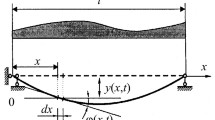Abstract
A complex of new methods for construction of analytical solutions to the problems of vibration or static deformation of elastic bodies (bars, disks, plates), which are modeled by differential second-order equations with variable coefficients, is described. The methods are based on group approaches, which make use of differential equation symmetries. Examples of analytical calculations of longitudinal vibrations of bars, torsional vibrations of disks, bending of round plates and axisymmetric tension of disks are given for the cases of variable characteristics where these calculations cannot be made by traditional analytical procedures.
Similar content being viewed by others
REFERENCES
1._ L. V. Ovsyannikov and N. Kh. Ibragimov, “Group analysis of differential equations of mechanics,” in: Itogi Nauki i Tekhniki: Obshchaya Mekhanika, Vol. 2, VINITI, Moscow (1975), pp. 5–52.
L. Collatz, Eigenwertaufgaben mit technischen Anwendungen, Akademische Verlagsgesellschaft, Leipzig (1963).
S. P. Timoshenko, A Course in Elasticity Theory [in Russian], Naukova Dumka, Kiev (1972).
A. P. Filippov, Vibrations of Deformable Systems [in Russian], Mashinostroenie, Moscow (1970).
B. G. Korenev, Some Problems of the Theory of Elasticity and Heat Conduction Solved in Bessel's Functions [in Russian], Fizmatgiz, Moscow (1960).
S. P. Timoshenko and J. N. Goodier, Theory of Elasticity, 3rd ed., McGraw-Hill Book, New York (1970).
E. Kamke, Differentialgleichungen, Lösungsmethoden und Lösungen. Gewöhnliche Differentialgleichungen, 6 verbesserte Auflage, Leipzig (1959).
A. G. Trapezon, “On a transformation and its properties in the problem of longitudinal vibrations of bars,” Probl. Prochn., No. 10, 71–77 (1993).
M. M. Pisarevskii, “Design of transfer bars for magnetostrictive vibrators,” in: Proc. Scientific-Technical Conf. on Energy Dissipation under Vibration of Elastic Bodies [in Russian], Izdatel'stvo Ac. Sci. UkrSSR, Kiev (1958), pp. 54–89.
A. G. Trapezon, Design of Elastic Elements in Resonance Fatigue Tests [in Russian], Naukova Dumka, Kiev (1983).
C. B. Biezeno und R. Grammel, Technische Dynamik, Springer, Berlin (1939).
S. Timoshenko and S. Woinowsky-Krieger, Theory of Plates and Shells, 2nd ed., McGraw-Hill, New York (1959).
V. I. Smirnov, A Course in Higher Mathematics [in Russian], Vol. 2, GITTL, Moscow (1951).
I. A. Birger and Ya. G. Panovko (Eds.), Strength, Stability, and Vibrations. Handbook in 3 volumes [in Russian], Mashinostroenie, Moscow (1968).
Author information
Authors and Affiliations
Rights and permissions
About this article
Cite this article
Trapezon, A.G. Group Approaches to the Vibration and Static Deformation Analysis for Bars and Disks. Strength of Materials 33, 380–391 (2001). https://doi.org/10.1023/A:1012416812818
Issue Date:
DOI: https://doi.org/10.1023/A:1012416812818



